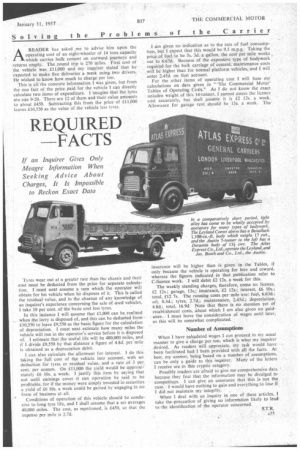REQUIRED FACTS
Page 75

If you've noticed an error in this article please click here to report it so we can fix it.
If an Inquirer Gives Only Meagre Information When Seeking Advice About Charges, It Is Impossible to Reckon Exact Data
AREADER has asked ,me to advise him upon the operating cost of an eight-wheeler of 14 tons capacity which carries bulk cement on outward journeys and returns empty. The round trip is 270 miles. First cost of the vehicle was £11,000 and my inquirer stated that he expected to make five deliveries a week using two drivers. He wished to know how much to charge per ton.
This is all the concrete information I was given, but from the one fact of the price paid for the vehicle I can directly calculate two items of expenditure. I imagine that the tyres are size 9-20. There are 12 of them and their value amounts to about £450. Subtracting this from the price of £11,000 leaves £10.550 as the value of the vehicle less tyres.
Tyres wear out at a greater rate than the chassis and their cost must be deducted from the price for separate calculation. I must next assume a sum which the operator will obtain for his vehicle when he disposes of it. This is called the residual value, and in the absence of any knowledge of an inquirer's experience concerning the sale of used vehicles, I take 10 per cent. of the basic cost less tyres.
In this instance I will assume that £1,000 can be realized when the lorry is disposed of, and this can be deducted from £10,550 to leave £9,550 as the basic figure for the calculation of depreciation, I must next estimate how many miles the vehicle will run in the operator's service before it is disposed of. I estimate that the useful life will be 480,000 miles, and if I divide £9,550 by that distance a figure of 4.8d. per mile is obtained as a depreciation debit.
can also calculate the allotment for interest. 1 do this taking the full cost of the vehicle into account, with no deduction for tyres or residual value, and a rate of 3 per cent, per annum. On £11,000 the yield would be approximately £6 10s. a week. I justify this item by saying that not until earnings cover it can operation be said to be profitable, for if the money were simply invested in securities a yield of £6 10s. a week could be gained by engaging in no form of business at all.
Conditions of operation of this vehicle should be conducive to-long tyre life, and I shall assume that a set averages 40,000 miles. The cost, as mpntioned, is £450, so that the expense per mile is 2.7d. I am given no indication as to the rate of fuel consumption, but I expect that this would be 9.5 m.p.g. Taking the price of Fuel to be 5s. 3d. a gallon, the cost per mile works out to 6.63d. Because of the expensive type of bodywork required for the bulk carriage of cement, maintenance costs will be higher than for normal platform vehicles, and I will enter 2.45d. on that account.
For the other items of operating cost I will base my calculations on data given in "'The Commercial Motor' Tables of Operating Costs." As I do not know the exact unladen weight of this 14-tonner, I cannot assess the licence cost accurately, but shall assume it is £2 12s. a week. Allowance for garage rent should be 13s. a week. The insurance will be higher than is given in the Tables, if only because the vehicle is operating for hire and reward. whereas the figures indicated in that publication refer to C-licence work. I will debit £2 12s. a week for this.
The weekly standing charges, therefore, come to: licence, £2 12s.; garage. 13s,; insurance, £2 12s.; interest, £6 10s.; total, £12 7s. The running costs per mile 'are: fuel, 6.63d.; oil, 0.3d.; tyres, 2.7d.; maintenance, 2.45d.; depreciation. 4.8d.; total, 16.9d. Note that there is no mention yet of establishment costs, about which I am also given no guidance. I must leave the consideration of wages until later, as this will be somewhat complicated.
Number of Assumptions
When I have calculated wages I can proceed in my usual manner to give a charge per ton, which is what my inquirer desired. As readers will appreciate, my task would have been facilitated had I been provided with al1 the facts. At best, my answer, being based on a number of assumptions, can be only a guide to this inquirer. Many of the letters I receive are in this cryptic category.
Possibly readers are afraid to give me comprehensive data because they fear that the information may be divulged to competitors. I can give an assurance that this is not the case. I would have nothing to gain and everything to lose if
I did not maintain my integrity. , When I deal with an inquiry in one of these articles, I take the precaution of giving no inforniation likely to lead to the identification of the operator concerned.












































































































